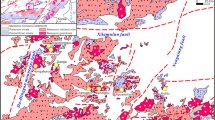Abstract
Situated in the Henan-Shaanxi fault-uplift area on the southern margin of the Sino-Korean Paraplatform, the Jinduicheng porphyry molybdenum deposit is the most important molybdenum producer in China. During Yenshanian the Jinduicheng granite porphyry was emplaced in metaspilite of the Proterozoic Xionger Group, controlled by a NW-trending fault. Mineral compositions are mainly quartz (25–40%), microcline and microcline-perthite (27–40%) and plagioclase (An 8–14, 14–32%), associated with minor biotite and muscovite, and phenocrysts are made up of K-feldspar, quartz and plagioclase. Accessory minerals include magmatite, apatite and zircon. The porphyry contains SiO2 73.83% and K2O + Na2O 8.06% (with K2O/Na2O ratio being 1.82), beloning to the calc-alkaline series.
Mineralization occurs in the porphyry body and biotitized and hornfelsized spilite within the exocontact zone. The maximum depth of mineralization reaches 1000 meters below the surface. According to mineral assemblage, ore veins are classified into five types: (1) pyrite-quartz; (2) pyrite-K-feldspar-quartz; (3) pyrite-molybdenite-quartz; (4) pyrite-molybdenite-K-feldspar-quartz; and (5) muscovitefluorite-pyrite-molybdenite-quartz.
As the most important economic molybdenum mineral, molybdenite occurs in various forms. Wall-rock alterations show a gross zonation of K-feldspathization-greisenization → silicification → propylitization from the porphyry outwards, of which silicification is most intense and has close genetic relationship with Mo mineralization.
Fluid inclusion studies yield homogeneous temperatures ranging from 250 to 240°C, with the main stage between 400 and 300°C. Gas inclusions frequently coexist with multiphase inclusions containing such daughter minerals as halite, sylvite, molybdenite and K-feldspar. Under moderate-high temperatures, lowerfo2, highfs2 and weak acidity conditions, boiling of ore-forming fluids is a prerequisite for the precipitation of molybdenite.
Sulfur, oxygen and carbon isotopic compositions suggest that at the high temperature stage (450°C) magmatic water is dominant and at the main ore-forming stage a mixture of magmatic water and meteoric water is expected. At the late stage, the mixture is predominated by meteoric water. Sulfur and molybdenum are mostly of magmatic origin.
Similar content being viewed by others
References
Ren Jishun et al., “Geotectonics of China and Its Evolutionn”, (A brief introduction to the Geotectonic Map of China (1:4 × 106), 1980, Science Press, Beijing (in Chinese).
Li Yingyun,Acta Geologica Sinica, 39, 3(1959), 237–246 (in Chinese).
Huang Dianhuao et al.,Acta Geologica Sinica, 58, 3(1984), 252–262 (in Chinese).
Huang Dianhuao et al.,Mineral Deposits, 3, 4(1984), 20–27 (in Chinese).
Huang Dianhuao et al.,Acta Geologica Sinica, 59, 3(1985), 241–255 (in Chinese).
Zheng Shuhui et al.,Kexue Tongbao (Science Bulletin), 28, 13(1983), 801–806 (Chinese edition).
Wallace, S.R. et al.,Econ. Geol., 73, 2(1978), 325–368.
White, W.H. et al.,Econ. Geol., 75th Aniversary Volume (1981), 270–316.
Giles, D.L. and Schilling, J.H.,The Proceedings of the 24th International Geological Congress, Section 10, Geochemistry, Montreal, Canada, 1972, 145–152.
Ohmoto, H. and Rye, R.O., “Geochemistry of Hydrothermal Ore Deposits”, New York, John Wiley and Sons, 1979, 509–567.
Taylor, H.P., Jr., Geochemistry of Hydrothermal Ore Deposits”, New York, John Wiley and Sons, 1979, 244–248.
Isuk, E.E. and Carman, J.H.,Econ. Geol., 76, 8(1981), 2222–2235.
Ryabchikov, I.D. et al.,Geoch. Inter., 18, 4(1981), 183–186 (trans. from Geochimiya, No. 8, 1243–1246).
Author information
Authors and Affiliations
Rights and permissions
About this article
Cite this article
Huang, D., Wu, C. & Nie, F. Geological features and genesis of the Jinduicheng porphyry molybdenum deposit, Shaanxi Province, China. Chin. J. of Geochem. 7, 136–147 (1988). https://doi.org/10.1007/BF02894967
Issue Date:
DOI: https://doi.org/10.1007/BF02894967




